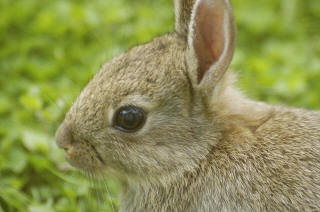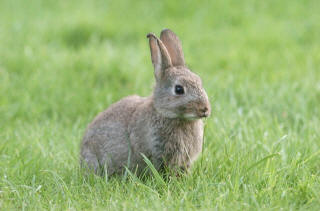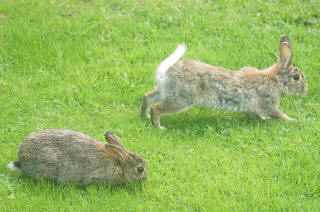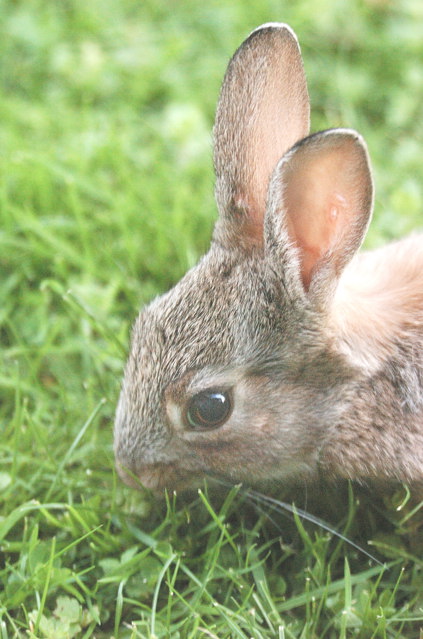Article
|
European
Rabbit
Latin Name:
Oryctolagus cuniculus
Is a species of rabbit native to south west
Europe, (Spain and Portugal) and was introduced into the UK by the Normans in
the 12th century to provide meat and fur. The only rabbit to be domesticated for
food or as a pet, it was first widely kept in ancient Rome and was refined into
a wider variety of breeds during the middle ages. It is the ancestor of all
domestic rabbits within the UK. In fact it has become so successful, in Nov 2004
there was thought to be around 40million in Britain, and it is considered a pest
in many areas.
|


 European Rabbit
European Rabbit
Click on image to see
larger version |
Identification
The European rabbit is a
small, grey-brown mammal and are smaller and less gangly than hares, and have
shorter ears. The tips of the ears are brown, and the upper surface of the tail
is dark brown. They have four sharp incisor teeth, two on top and two on bottom,
that continuously grow throughout their life. They also have two peg teeth
behind each set of incisors. They have long ears. large hind legs and short
fluffy tails, with a characteristic white flash on the underside of the tail can
be seen when the animal is fleeing. They move about by hopping, using their long
powerful hinds legs, and to facilitate quick movement their hind feet have a
thick padding of fur to dampen the shock of rapid hopping. Their toes are long,
and are webbed to keep from spreading apart as they jump.
|
Animal
Facts
In Britain: All year round
Life Span: Up to 9 years
Statistics:
Head-body length: 30-40cm, Weight: 1.2-2kg.
Habitat: Can be found on heathland, open
meadow, grassland, woodland, the fringes of agricultural land and dry sandy
soil, including sand dunes, but they avoid coniferous forests.
Food: Grass is their primary food source
although they will eat the leaves of a wide range of vegetation including
agricultural crops, cereals, young trees and cabbages. In winter, they will eat
grasses, bulbs and bark. They are also known to re-ingest their faeces for
nutritional benefit.
|
Conservation
Status

Least Concern |
Breeding: Mating occurs throughout the year
with most litters born between February and August. Mating amongst the wild
population is rather complicated where you have dominant males exhibiting
polygamy, whereas lower status individuals often form monogamous breeding
partnerships. Litters can range in size between 3 and 12, after a gestation
period of 28-33 days, and the kittens are weaned after 28 days. Young are born
blind and furless and are totally dependent on their mother, who returns to the
warren once a day for 4 weeks in order for them to suckle.
Distribution:
They are widespread in western Europe, including the UK, Balearic Islands,
Corsica, Sardinia, Sicily and can also be found in North Africa. They have also
been introduced to Australia, New Zealand and North and South America.
|
Behaviour:
They use a burrow system known as a warren,
primarily excavated by the female, and tunnels can be 1-2m long. The nest at the
end of the tunnel is lined with grass, moss and belly fur. They use regular
trails, which they scent mark with faecal pellets. In the wild they are social
animals living in medium sized colonies. They are largely active around dawn and
dusk, although they will be seen around during the day.
It is the most social rabbit, sometimes forming
groups in warrens of up to 20 individuals. However, even in European rabbits,
social behaviour can be quite flexible, depending on habitat and other local
conditions, so that at times the primary social unit is a territorial breeding
pair. Most rabbits are relatively solitary and sometimes territorial, coming
together only to breed or occasionally to forage in small groups. During
territorial disputes rabbits will sometimes “box,” using their front limbs.
They are active throughout the year and are
generally nocturnal, and they are also relatively silent. Other than loud
screams when frightened or caught by a predator, the only auditory signal known
for most species is a loud foot thump made to indicate alarm or aggression. Wild
rabbits can be extremely aggressive and competition between males can often lead
to severed injury and death. Although hostile displays are used, and males often
squirt urine on challengers as a form of territorial marking, the most common
response to a challenge is immediate attack. They use their powerful back legs
as weapons, kicking at an opponent's underside, as well as biting and scratching
with the front paws.
When not feeding or fighting they spend most of
their time in their warrens.
|


 European Rabbit
European Rabbit


 European Rabbit
European Rabbit
Click on images to see
larger versions |
Instead of
sound, scent seems to play a predominant role in their communication systems.
They possess glands throughout their body and rub them on fixed objects to
convey group identity, sex, age, social and reproductive status, and territory
ownership. Urine is also used in chemical communication. When danger is
perceived, the general tendency of the rabbit is to freeze and hide under cover.
If chased by a predator, they engage in quick, irregular movements, designed
more to evade and confuse than to outdistance a pursuer. They have been down to
get up to speeds of 80 km [50 miles] per hour.
Conservation Status:
Populations are increasing, as they are
becoming immune to the myxomatosis virus. Rabbits become sexually mature after
just four months and breed rapidly, so they can readily replace themselves.
Other points to note:
|
The European rabbit in the wild occupies open
landscapes such as fields, parks, and gardens. Drive anywhere in the UK
countryside and you are likely to see a rabbit, feeding on the side of the road
and playing dodgems with the traffic or feeding peacefully in the open fields.
You will come across rabbits of all ages and it is not uncommon to see a number
of young rabbits together feeding or chasing each other. They are inquisitive
creatures and when approached will stay completely still. But don't be fooled
they may look like they are unaware of what is going on around them, but that is
not they case, if something should occur like a bird of prey fly over, they will
scatter and fast.
They are considered a pest by many and can do a
lot of damage in fields and on railway embankments where they decide to build
their warrens. And for this reason various methods have been used to destroy
local populations such as gassing, barriers (fences), shooting, snaring and
ferreting have been used to try to control populations.
Rabbits are known by many names. Young rabbits
are known by the names bunny, kit, or kitten. A male rabbit
is called a buck, and a female rabbit is called a doe. A group of
rabbits is known as a colony or a nest. They are affectionately
know by the pet name 'bunny', 'bunnies' or 'bunny rabbit'.
Their reproductive abilities led to the phrase
'breeding like rabbits'. There are many
fictional rabbits including Peter Rabbit, the mischievous young rabbit in the
Beatrix Potter stories and the White Rabbit in Alice and Wonderland by Lewis
Carroll as well as the well known cartoon character Bugs Bunny. |

 European Rabbit
European Rabbit |
One final point:
If you are lucky you will get them in your back
garden and at a previous house we lived at we had wild rabbits routinely visit
our garden where much of it was grass. Mums would bring their offspring into the
garden to feed and frolic in the summer sunshine. Living on the side of a steam
railway line, where there were many holes in the embankment, and fields on the
other side, they would come across the railway into the garden where they knew
it was safe, and our borders with shrubs and honeysuckle along the fences would
provide shelter if a predator should approach. We would leave out water and they
would come and drink, and come quite close to the house so we were able to get
many photographs of them, both close up portrait shots and action shots of the
young ones chasing each other around the garden, or just trying to keep up with
mum as she foraged on the grass. They would also at times hide under our cars
out of harms way. Generally they would appear late afternoon and into the early
evening during the summer months, when most of the garden was in shade from the
hot sun, but we did see them at other times. All the pictures on this page
were taken in our garden.
|